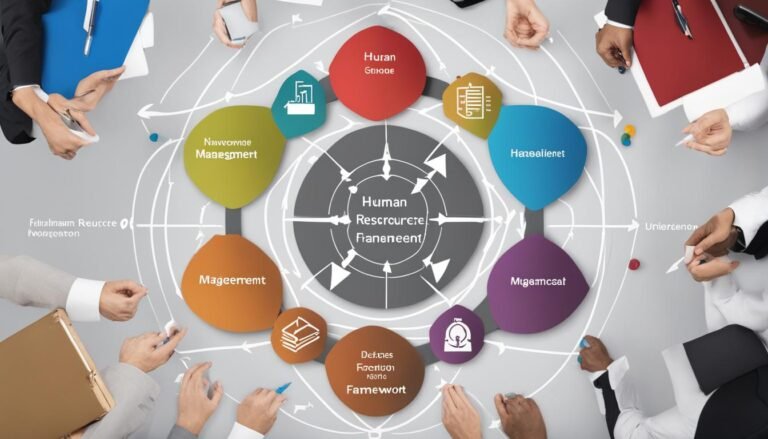A Guide to Human Resource Planning
Human resource planning, also known as workforce planning, is a strategic process that helps organizations analyze their current workforce and forecast future needs. It involves analyzing current workforce performance, aligning with business strategy, identifying skills gaps, and developing strategies to fill those gaps. HR planning is essential for optimizing the use of current resources, enabling better succession planning, starting the development of new skills early, and linking business and HR performance.
Key Takeaways:
- Human resource planning, or workforce planning, is a strategic process that helps organizations analyze their current workforce and forecast future needs.
- It involves aligning with business strategy, identifying skills gaps, and developing strategies to fill those gaps.
- HR planning optimizes the use of current resources, enables better succession planning, and links HR decisions with business performance.
- Effective human resource planning involves analyzing current workforce performance, forecasting future needs, and identifying and filling skills gaps.
- By following the steps of the planning process, organizations can achieve HR optimization and workforce success.
What is Human Resource Planning?
Human resource planning, also referred to as workforce planning, is a strategic process that ensures organizations have the right staffing levels to meet their current and future business needs. It involves analyzing the performance of the current workforce, aligning HR strategies with overall business goals, identifying gaps in the workforce, and developing strategies to fill those gaps.
The purpose of human resource planning is to optimize the use of current resources, enable better succession planning, start developing new skills early, and link business and HR performance.
One of the key aspects of human resource planning is analyzing the performance of the current workforce. This involves assessing the skills, capabilities, and performance of employees to identify strengths and weaknesses.
“Human resource planning, also referred to as workforce planning, is a strategic process that ensures organizations have the right staffing levels to meet their current and future business needs.”
Effective human resource planning helps organizations align their workforce with business objectives and drive success.
Aligning human resource strategies with overall business goals is another crucial aspect of human resource planning. It involves understanding the organization’s long-term goals, growth plans, and future workforce requirements.
Identifying gaps in the workforce is a vital step in human resource planning. These gaps can be related to skills, capabilities, or the number of employees needed in specific roles.
- Skills gaps: These occur when there is a disparity between the skills required for a particular role and the skills possessed by the current workforce.
- Capability gaps: These gaps involve the absence of necessary competencies or abilities in the organization to achieve business goals.
- Workforce gaps: These gaps emerge when there is an insufficient number of employees in a specific role, leading to a lack of resources to fulfill business needs.
Once gaps in the workforce have been identified, organizations can start developing strategies to fill those gaps. This may involve implementing training and development programs to enhance the skills and capabilities of current employees, recruiting new talent, or reassigning resources within the organization.
In conclusion, human resource planning is a critical process that ensures organizations have the right people with the right skills to drive success. By analyzing workforce performance, aligning HR strategies with business goals, and addressing gaps in the workforce, organizations can optimize their human resources and achieve their objectives.
The Purpose of Human Resource Planning
In the fast-paced and ever-changing business landscape, human resource planning plays a vital role in ensuring organizations are prepared for the future and equipped with the right talent to navigate challenges. With a strategic approach towards HR planning, organizations can optimize their current resources, identify untapped skills, and align HR decisions with overall business performance and growth.
By delving into the purpose of human resource planning, organizations gain insight into its significance.
Optimizing the Use of Current Resources
One of the key purposes of HR planning is to optimize the utilization of existing resources within an organization. Through robust analysis of the current workforce, organizations can identify additional capacity and tap into the untapped potential of their employees. This enables businesses to make informed decisions about resource allocation, ensure efficient staffing, and maximize productivity.
Enabling Better Succession Planning
Succession planning is a critical aspect of HR strategy, and human resource planning facilitates this process. By identifying potential leadership gaps in the future, organizations can proactively develop and nurture employees to fill those roles. This strategic approach to succession planning ensures a smoother transition of leadership, minimizes disruptions, and maintains continuity in business operations.
Starting the Development of New Skills Early
HR planning also enables organizations to start the development of new skills early, aligning with the evolving needs of the business. By identifying future skill requirements through comprehensive analysis, organizations can invest in training and development initiatives to equip employees with the necessary competencies. This proactive approach helps organizations stay ahead of industry trends, enhance their competitive edge, and foster a culture of continuous learning and growth.
Linking HR Decisions to Business Performance and Growth
Effective HR planning ensures a strong alignment between HR decisions and overall business performance and growth. By analyzing workforce data, organizations can make data-driven decisions to support their strategic objectives. This includes hiring decisions, talent acquisition strategies, and resource allocation. This alignment between HR and business goals leads to increased efficiency, productivity, and profitability.
Overall, the purpose of human resource planning is multi-fold. It optimizes the use of current resources, enables better succession planning, fosters the development of new skills, and links HR decisions to business performance and growth. By embracing HR planning as a strategic imperative, organizations can position themselves for success in an ever-changing business landscape.
Steps of the Human Resource Planning Process
The human resource planning process involves several steps to ensure effective workforce management. By following these steps, organizations can align their workforce with business goals and optimize talent management.
Analyzing Current Workforce Performance
First, organizations need to analyze the current workforce performance to assess skills and performance. This involves gathering data on employee skills, performance, compensation, and satisfaction. By analyzing this data, organizations can identify skills gaps, determine training needs, and make informed decisions about resource allocation. Workforce analytics and performance management systems help gather the necessary information for this analysis.
Forecasting Future Needs
After analyzing the current workforce, the next step is to forecast future needs based on the organization’s business strategy. This involves assessing long-term goals and industry trends to determine the skills and number of employees required. Organizations can gather information through industry analysis, competitor research, and considering potential changes in the labor market. Accurately forecasting future needs allows organizations to proactively plan for talent acquisition and ensure they have the right people in place to support business growth.
Identifying Skills Gaps
Once future needs have been forecasted, organizations need to identify any gaps between the current workforce and future requirements. This process, known as supply and demand analysis, involves creating a skills inventory to compare existing skills with the skills needed in the future. It’s important to understand the surplus of certain skills that may not be needed and plan for reskilling or reassigning employees accordingly. Identifying skills gaps helps organizations determine the best approach for filling those gaps, whether through training current employees or hiring new talent.
Developing a Plan to Fill Gaps
Once gaps in skills and workforce have been identified, organizations need to develop a plan to fill those gaps. This plan should be aligned with the overall business strategy and budget. Organizations can evaluate alternative solutions such as upskilling current employees or hiring externally. Employee retention strategies and succession planning are crucial aspects of talent management to prevent the loss of top talent and ensure a smooth transition in key leadership positions. Decisions on filling skills gaps should be based on cost-effectiveness and long-term business goals.
Monitoring and Adjusting the Plan
The human resource planning process is not static and requires continuous monitoring and adjustment. Organizations need to regularly assess the effectiveness of their workforce management strategies and make necessary adjustments. This can involve evaluating the impact of implemented changes, identifying new skills gaps, and making modifications to the workforce plan. By consistently monitoring and adjusting the plan, organizations can ensure that their talent management efforts remain aligned with business goals.
Analyzing Current Workforce Performance
When it comes to effective HR planning, the first step is to analyze the current workforce performance. This crucial process involves gathering data on employee skills, performance, compensation, and satisfaction to gain a comprehensive understanding of the current landscape.
There are several avenues through which organizations can obtain this valuable data. Employee surveys serve as a great tool for gathering insights and feedback directly from employees. Performance management systems provide a wealth of information on individual and team performance, while talent management reports offer valuable insights into employee development and potential.
By analyzing current workforce performance, organizations can identify any existing skills gaps within their teams. This knowledge enables them to determine which employees require additional training or development to fill these gaps adequately. Additionally, analyzing workforce performance allows organizations to make informed decisions about resource allocation, ensuring that the right employees are assigned to the right tasks based on their skill sets and abilities.
“Analyzing current workforce performance is the foundation of effective HR planning. It provides crucial insights into areas of strength, identifies areas for improvement, and enables organizations to optimize their resources for maximum productivity and success.” – Jane Thompson, HR Manager at XYZ Company
By leveraging workforce analytics and performance management tools, organizations can gain valuable insights into employee performance and make data-driven decisions. This data empowers HR departments to identify high-performing individuals, facilitate employee development plans, and align the workforce with business objectives.
In conclusion, analyzing current workforce performance is a critical step in effective HR planning. By leveraging workforce analytics and utilizing data-driven insights, organizations can identify skills gaps, develop targeted training programs, and optimize resource allocation. This process enables businesses to align their workforce with strategic objectives and drive long-term success.
Forecasting Future Needs
After analyzing the current workforce performance, the next critical step in HR planning is to forecast future needs. By assessing the organization’s long-term goals and business plans, HR professionals can determine the skills and number of employees required to meet those goals. To gather the necessary information, organizations can focus on industry analysis, competitor research, and carefully considering potential changes in the labor market.
Accurately forecasting future needs plays a crucial role in proactive talent acquisition, ensuring that organizations have the right people in place to support business growth. It allows HR teams to plan ahead, anticipate workforce demands, and strategically acquire the talent needed to fill critical positions.
Industry Analysis
Conducting industry analysis helps HR professionals gain insights into industry trends, market conditions, and potential challenges or opportunities that may impact workforce requirements. By monitoring industry developments, organizations can anticipate changes that may necessitate adjustments in skill sets, staffing levels, or talent acquisition strategies.
Competitor Research
Studying competitors’ strategies, workforce composition, and areas of expertise provides valuable benchmarking information. Understanding how other organizations in the same industry structure their workforce and invest in talent acquisition can help HR professionals identify best practices and areas for improvement. Competitor research can also shed light on emerging roles or skills that may be vital to future success.
Predicting Labor Market Changes
The labor market is dynamic and subject to fluctuations influenced by economic factors, technological advancements, and societal shifts. HR professionals must consider both short-term and long-term labor market trends that may impact their organization. By accurately predicting labor market changes, HR teams can proactively adjust their talent acquisition strategies, making informed decisions when hiring, training, and developing their workforce.
Strategic Talent Acquisition
Forecasting future needs allows HR professionals to strategically plan for talent acquisition and ensure that the organization has a pipeline of qualified candidates ready to meet upcoming demands. It enables effective workforce planning by identifying critical roles that may require succession planning or specific skills that need to be acquired externally. By integrating talent acquisition into the HR planning process, organizations can cultivate a skilled and diverse workforce, ready to drive business success.
Identifying Gaps
Once future needs have been forecasted, the next step in HR planning is to identify any gaps between the current workforce and future requirements. This process, known as supply and demand analysis, involves creating a skills inventory to compare existing skills with the skills needed in the future. By conducting a thorough skills inventory, organizations can gain insights into the strengths and weaknesses of their workforce.
Identifying these gaps is crucial for effective HR planning, as it allows organizations to understand the supply and demand dynamics of their talent pool. It helps them determine whether they have a surplus or shortage of certain skills and expertise. By identifying surplus skills, organizations can explore opportunities for reskilling or reallocating employees to areas where their competencies are most needed.
On the other hand, identifying skills gaps provides organizations with the necessary information to devise strategies for addressing the shortages. These strategies can include implementing training and development programs to upskill existing employees or attracting new talent externally. By recognizing the gaps, organizations can take proactive measures to close them and ensure a well-balanced and capable workforce.
Identifying gaps in the workforce is like conducting a talent health check-up. It enables organizations to diagnose any deficiencies and take the necessary steps to rectify them before they impact business outcomes.
Benefits of Identifying Gaps
The process of identifying gaps in the workforce offers several benefits to organizations:
- Optimized HR Planning: By understanding the supply and demand dynamics of their talent pool, organizations can develop more accurate and effective HR plans. They can align their workforce strategies with their business goals and ensure they have the right skills at the right time.
- Strategic Resource Allocation: Identifying skills gaps helps organizations allocate their resources strategically. They can prioritize areas that require development, whether it’s implementing training programs or bringing in new talent, to ensure optimal productivity and performance.
- Enhanced Talent Management: Gaining insights into skills gaps allows organizations to implement targeted talent management initiatives. They can focus on developing and retaining employees with critical skills, creating a pipeline of future leaders, and fostering a culture of continuous learning and growth.
By effectively identifying and addressing gaps in the workforce, organizations can position themselves for long-term success. They can build a resilient and agile workforce that is equipped with the skills and capabilities needed to navigate future challenges and drive organizational growth.
Skills Inventory
A key element of the gap identification process is conducting a comprehensive skills inventory. This involves assessing the skills and competencies of employees across various roles and departments. A well-executed skills inventory provides organizations with a clear understanding of the capabilities within their workforce.
| Employee | Department | Role | Primary Skills | Secondary Skills |
|---|---|---|---|---|
| John Smith | Sales | Sales Manager | Sales Strategy, Relationship Management | Market Analysis, Customer Service |
| Jane Johnson | Marketing | Marketing Specialist | Digital Marketing, Content Creation | SEO, Social Media Management |
| Mike Davis | Finance | Financial Analyst | Financial Modeling, Data Analysis | Budgeting, Forecasting |
The skills inventory helps organizations identify the current skills available within the workforce and gaps that need to be addressed. It serves as a valuable tool for workforce planning, talent development, and succession planning.
Filling Skills Gaps
Once gaps in skills and workforce have been identified, organizations need to develop a plan to fill those gaps. This plan should be aligned with the overall business strategy and budget. It’s crucial to invest in employee retention strategies to prevent the loss of top talent, ensuring their expertise remains within the organization. This can be achieved through measures such as offering competitive compensation and benefits packages, providing opportunities for career growth and development, and fostering a positive work environment.
Employee retention is not only cost-effective but also contributes to enhanced productivity, knowledge retention, and a positive company culture.
Succession planning plays a vital role in filling skills gaps as well. By identifying employees who possess the necessary skills or potential for growth, organizations can groom them for future leadership roles. This involves providing training and mentorship opportunities, delegating challenging projects, and creating a clear career progression path. In doing so, organizations ensure a smooth transition when key positions become vacant and minimize any disruption to business operations.
Decisions regarding whether to upskill current employees or hire externally should be based on cost-effectiveness and long-term business goals. Upskilling existing employees can be a practical investment, as it allows organizations to leverage their knowledge and experience while addressing specific skills gaps. On the other hand, hiring externally may bring fresh perspectives and specialized expertise, particularly in highly competitive or rapidly evolving industries.
Conclusion
Human resource planning is a strategic process that organizations should embrace to optimize their workforce and achieve alignment with their business goals. By carefully analyzing the current performance of their workforce, organizations can identify strengths and weaknesses, allowing them to take proactive measures to address any skills gaps that may exist. With accurate forecasting of future needs, organizations can ensure they have the right people with the right skills in place to drive success.
Additionally, human resource planning enables better succession planning, which is crucial for seamless leadership transitions and the continuity of business operations. By identifying and developing potential successors early on, organizations can mitigate the risks associated with unexpected departures or retirements of key personnel.
Furthermore, human resource planning facilitates the early development of new skills, ensuring that employees are equipped with the abilities needed for future challenges. By investing in their workforce’s growth and development, organizations can cultivate a culture of continuous learning and innovation, fostering a competitive advantage in today’s rapidly evolving business landscape.
Overall, human resource planning is essential for organizations to optimize their HR capabilities and enhance workforce success. It acts as a bridge between HR decisions and business performance, providing the strategic framework needed to align talent management efforts with the overall objectives of the organization. By following the steps of the planning process and embracing HR optimization, organizations can ensure they have the right people in the right places, driving success and creating a sustainable competitive edge.







